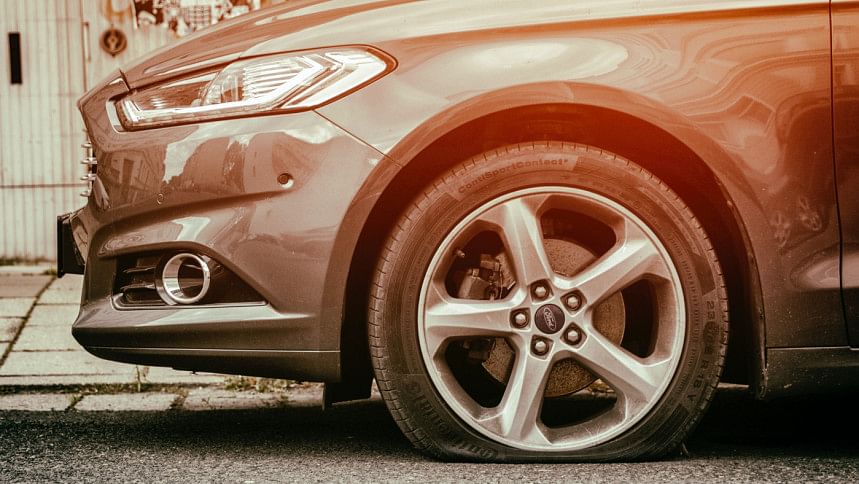How to change flat tyre for dummies

You are driving down the road, the weather is nice (less hot), and traffic is bearable (moving at a snail's pace). Then you ponder how things are going well and how much you have been missing a day like this. Then all of a sudden, the ever-kind universe showers its blessings upon you with a flat tyre on the streets of Dhaka. Suddenly the weather gets scorching and the world around you slows down. You realise that it was your yearning for a good day while inhaling carbon monoxide (chemical formula CO) from the local buses that made the day tolerable. After snapping out of the CO-induced daydream, the reality of the flat tyre hits. What can you do? What rocket science would you have to master to change a flat tyre? You do what anyone would do, google how to change a tyre. Which is why you are now reading this article.
Here are the easy steps for changing tyres for the uninitiated.
Find a safe place to pull over
Find a side of the road safe to pull over. Make sure the space is solid and level to keep your car from rolling. Do not park near corners or bends in the road, this will reduce visibility for both you and other drivers. If you get a flat tyre during night time or in an unsafe area, turn on the emergency light and carefully drive to a better spot.
Use your emergency/hazard lights and parking brake
Use your emergency/hazard lights to keep yourself and your vehicle safe by increasing your visibility. It is important to remain visible at all times during any mechanical car issues. When you have decided on the spot to stop, apply parking brakes — it decreases the vehicle's ability to roll.
Check for materials
To get your car functional again, you will need a jack, wrench, and a spare tyre. In the case of a flat tyre, these three items should always be in your vehicle. Additional items that can make tyre changing a little easier include:
- Flashlight
- Gloves
- Mat for kneeling
- Rain Coat
- Tyre gauge
- Your vehicle's owner's manual
Lift your vehicle off the ground
Place the jack under the metal portion of your vehicle's frame. Place it anywhere else other than the metal portion and you will crack the plastic moulding of your car's body. The best jack placement differs depending on the vehicle. Look underneath the car for the metal portion; it's hard to miss or take a quick look at the owner's manual and learn proper jack placement. Once properly placed, use the jack to raise the tyre you are changing off of the ground. Ensure the jack stays perpendicular to the ground at all times. For SUVs, if you do not possess a proper jack that lifts the vehicle high enough, take two bricks side by side and place the jack on top of the bricks. It should do the trick.
Loosen the lug nuts
If your car has a wheel cover (also known as a hubcap), pry it off with a flat screwdriver. Then, secure the wrench onto a lug nut, and turn it counter clockwise to loosen it. It will require strength! Repeat this process with each lug nut, making sure each one is loose enough to turn by hand.
Remove the lug nuts and the tyre
Turn the lug nuts counter clockwise until they are all very loose and remove them completely. Keep the lug nuts together in a safe spot. DO NOT LOSE THEM! You will need them to secure the spare tyre. With the lug nuts removed, attach the spare tyre to the vehicle.
Place the spare tyre on the car and the lug nuts
With the lug nut posts aligned, line up the holes in the spare tyre and place the spare on the wheelbase. Push the spare as far onto the wheelbase as possible. Put the lug nuts back on so the spare tyre stays put. It's very important to tighten your lug nuts to keep the tyre even all the way through.
Lower your vehicle and tighten the lug nuts
Slowly lower your vehicle until your car is grounded, using the jack. This holds the tyre in place as you begin tightening the lug nuts. Tighten the lug nuts in increments, alternating every other nut. In order to secure the lug nuts as tightly as possible, you can add your own weight to the wrench until the nuts no longer budge.
Extra tips
Finish up by putting your old tyre in the trunk. Your old tyre might be salvageable depending on what's wrong with it. Take it to a mechanic, trusted, if possible, who can test and possibly repair it. If it is not salvageable, immediately invest in a new spare. Refrain from operating a vehicle without a spare tyre; make sure the spare tyre is ready to use in an emergency.

 For all latest news, follow The Daily Star's Google News channel.
For all latest news, follow The Daily Star's Google News channel. 








Comments